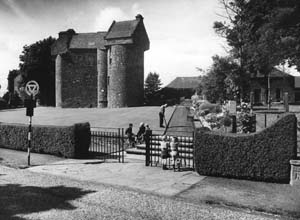
This is just about the most prosaic and unprepossessing name that could have been given to a castle. It must in origin have referred to some long-forgotten clay-pottery in the vicinity, which eventually gave its name also to a main road, and has more recently been adopted by a Terrace, a Place, a Court and Gardens.
To imagine the castle in its heyday we must mentally eliminate all these features, instead, imagine the castle standing on the verge of an ornamental lake (later a skating pond, now drained), with views south over the fields sloping down to the river and north to the Grampian foothills.
The lands of Claypotts belonged to the barony of Dundee and as such came into the possession of David, Earl of Huntingdon, at the end of the twelfth century, as a gift from his brother William the Lion. Alexander II granted the feudal superiority of the lands to the Abbey of Lindores, and in the sixteenth century the feu came to be held by John Strachan of the family of Carmyllie. His son, also John, started building the castle in 1569; the initials ‘I.S.’ (Iohannes Strachan) on one of the stones with the date 1588 show that the castle took almost twenty years in the building.
Most Dundonians, even those speeding along Arbroath Road, will be familiar with the castle’s external appearance, unchanged for centuries. In architectural terms it is a good example of a Z-plan keep, with two circular towers capped with square attic towers, corbelled from below with crow-step gabling. It is roofed with grey flake stones, as characteristic of Angus as red pantiles are of Fife.
Claypotts Castle has not had a happy history. During its tenure by the Strachans there were attacks, sieges, an attempted kidnapping and numerous matrimonial disputes, often ending in violence. Since ours is an unromantic and incredulous age, we perhaps no longer have need of legends such as that of the white lady who, every 19th March, stands at one of the upper windows wringing her hands and waving a kerchief in the direction of her lover in his castle in distant St. Andrews. (The lady is supposed to be Marion Ogilvy, her lover Cardinal Beaton: but the fact that Miss Ogilvy never lived in Claypotts, which in any case is not visible from St. Andrew’s Castle, must render the story apocryphal).
In the 1600s the superiority of the lands passed to the Scrymgeours, who gave a charter of Claypotts to Sir William Graham of Claverhouse; the property remained in the Graham family for three generations, one of which included John Graham. This produced a new crop of legends: John Graham, Viscount Dundee, traduced by historians and reviled by the Presbyterian kirk, probably resided from time to time at the castle, but there is no basis for the stories of wild orgies, of witches’ covens, bargains with Auld Nick, and other unseemly goings-on which were once associated with Claypotts. Nor do we deal much nowadays with legends of fiery black charges from the devil’s stable nor with the silver button which was responsible for the death of (bullet-proof) Bonnie Dundee; and the baleful fires which were said to light up the castle every Hallowe’en could now scarcely be seen above the lights of Claypotts roundabout.
Source: ‘Dundee Names, People and Places’ – David Dorward
